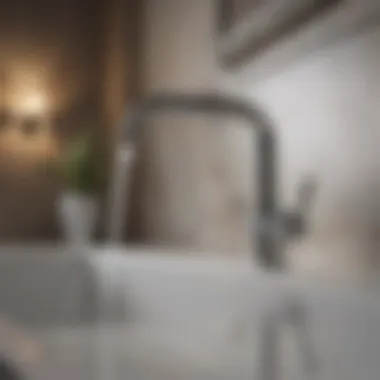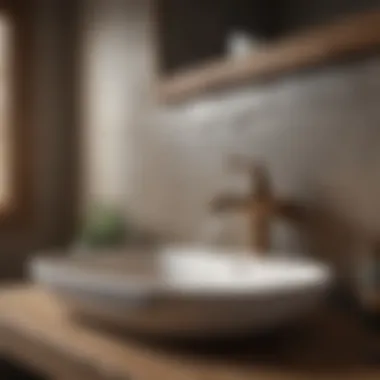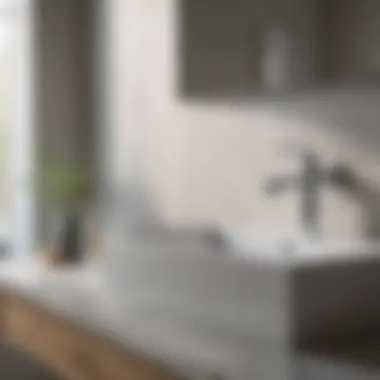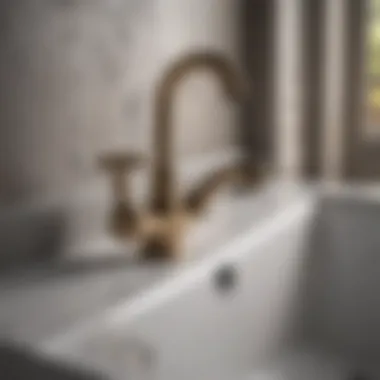Innovative Master Bathroom Faucet Ideas for 2023


Intro
When it comes to designing a master bathroom, the faucet is often an overlooked element. It might seem trivial, but the right faucet can significantly influence functionality, style, and overall ambience. In this guide, we explore various innovative ideas for master bathroom faucets, taking into consideration current trends, materials, and installation methods. By focusing on both aesthetic appeal and practical use, this article aims to assist homeowners and design enthusiasts alike in selecting the ideal fixtures to elevate their bathroom experience.
Design Inspirations
Modern vs. Traditional Bath and Bedroom Styles
The design of a faucet can reflect two primary styles: modern and traditional. Modern faucets typically feature sleek lines and minimalistic designs. They often incorporate materials like brushed nickel or chrome, providing a contemporary flair that complements modern bathrooms.
In contrast, traditional faucets tend to focus on intricate details and classic finishes such as oil-rubbed bronze or polished brass. These designs often include decorative handles and an elegant silhouette, which can enhance a more traditional or vintage-inspired bathroom.
Choosing between these two styles requires an understanding of the overall design aesthetic of the home. A modern faucet might clash in a traditionally decorated room, and vice versa. Therefore, aligning faucet design with the current elements of the bathroom is crucial for a cohesive look.
Color Palettes and Textures
Color selection plays a vital role in achieving the desired atmosphere in a master bathroom. A monochromatic scheme may feature faucets in shades of white, gray, or black, promoting a clean and sophisticated look. On the other hand, a bolder color palette could introduce unexpected elements like gold or pastel hues in faucet designs.
Textures also impact the selection process. For instance, matte finishes provide a more subdued and contemporary feel, while glossy surfaces may evoke glamor and luxury. When pairing a faucet with other elements—such as sinks, countertops, and tiles—achieving harmony in color and texture helps create a seamless visual experience.
Product Reviews
Bathtubs and Showers
Selecting faucets for bathtubs and showers often involves various styles and functions. Wall-mounted faucets can save space in bathrooms where surface area is limited. Similarly, freestanding tubs are becoming popular; they require specific floor-mounted faucets, which can stand as a centerpiece.
Vanity and Sink Options
When choosing faucets for vanities, consider the style of the sink. Sink types range from undermount to vessel, and each may have specific faucet requirements. For instance, vessel sinks often pair well with tall faucets that can complement their elevated design. The finish and style should correspond to the overall vanity design, whether rustic, contemporary, or classic.
"The right choice of faucet elevates not just functionality, but also the aesthetic of your master bathroom."
In summary, making an informed decision regarding faucet designs entails evaluating various factors such as style alignment, color palettes, and associated fixtures. A well-chosen faucet not only enhances daily use but also adds significant value to the overall bathroom experience.
As we explore further, we will dissect key trends in faucet technology as well as maintenance tips that preserve their elegance and efficiency.
Intro to Master Bathroom Faucets
Selecting the right faucet for a master bathroom is a decision that combines both aesthetics and functionality. The faucet serves as a focal point in a bathroom, influencing the overall design and feel of the space. Therefore, understanding its significance is not just about plumbing; it is about enhancing a homeowner's daily experience.
Importance of Choosing the Right Faucet
Choosing an appropriate faucet can impact various factors, such as convenience, hygiene, and water efficiency. A well-selected faucet can save money on water bills through efficiency features while also contributing to the comfort of the users. The tactile experience of holding the handle, the familiarity of the controls, and the ability to intuitively adjust water temperature all contribute to the usability of the faucet.
"The right faucet becomes an extension of the user's needs, making everyday activities smoother and more enjoyable."
Moreover, the aesthetic appeal of the faucet can tie together the design elements of the bathroom. Whether a homeowner prefers a modern, sleek faucet or a vintage-looking one, the right choice reflects personal style. A poor selection could lead to dissonance in design and potentially diminish the value of the home in the eyes of potential buyers.
Overview of Current Trends
The current marketplace features innovative designs and technologies that cater to the diverse preferences of consumers. Smart faucets are a significant trend, allowing users to control water flow via voice commands or touchless controls, which enhances hygiene. Water-saving features are also prevalent as more homeowners seek to reduce their ecological footprint without sacrificing performance.
Color and material choices have diversified as well. While chrome and stainless steel remain popular, finishes like matte black and brushed gold are gaining traction. These contemporary options allow for more personalized bathroom designs. Trends indicate a shift toward combining practicality with stylish elements, where the faucet can embody both functionality and high design.
Types of Master Bathroom Faucets
Understanding the different types of master bathroom faucets is essential for homeowners looking to enhance their bathrooms. The type of faucet chosen can greatly influence both the aesthetic appeal and functionality of the space. Each type of faucet offers distinct benefits and considerations that may align more closely with individual preferences and needs. Therefore, familiarity with available options empowers homeowners to make informed choices, contributing to an overall harmonious bathroom design.
Single-Handle Faucets


Single-handle faucets are characterized by their simplicity and ease of use. These faucets operate with a single lever to control both the flow and temperature of the water. This design reduces the clutter on the countertop and allows for quick adjustments, which can be especially beneficial in busy households. Furthermore, many single-handle models are designed with modern aesthetics in mind, making them a popular choice for contemporary bathrooms.
Prominent brands such as Moen and Delta offer single-handle faucets that incorporate advanced technology, yet retain an uncomplicated appearance. These faucets are also relatively easy to install, making them a favored option for DIY enthusiasts. However, it is crucial to consider whether the style complements the overall bathroom décor to achieve visual cohesion.
Double-Handle Faucets
Double-handle faucets feature separate handles for hot and cold water, giving users more precise control over water temperature. This control can be particularly appealing for those who prefer a specific mix of water temperatures when washing hands or performing grooming tasks. Additionally, double-handle faucets often offer a classic or traditional look that many homeowners desire for a more timeless bathroom aesthetic.
While these faucets can sometimes be more challenging to install compared to their single-handle counterparts, they nonetheless provide an opportunity for homeowners to express their unique style through various designs and finishes, such as brushed nickel or polished chrome. Brands like Pfister and Kohler have strong offerings in this category, catering to those interested in combining elegance with functionality.
Wall-Mounted Faucets
Wall-mounted faucets are gaining popularity in modern bathroom designs, allowing for a clean, uncluttered countertop. This type of faucet is installed directly on the wall above the sink, freeing up valuable sink space. This installation technique is especially beneficial in smaller bathrooms where maximizing space is crucial.
One potential drawback is that wall-mounted faucets generally require more complex plumbing configurations, which can raise installation costs and necessitate professional help. Despite this, the aesthetic appeal and sleek profile of wall-mounted faucets can dramatically elevate a bathroom's style. Brands like Brizo are known for their innovative wall-mounted designs, often featuring modern lines and artistic finishes, catering to discerning homeowners.
Touchless Faucets
Touchless faucets represent a significant advancement in technology, allowing users to operate the faucet without physical contact. This feature not only enhances convenience but also promotes hygiene, minimizing the risk of spreading germs. Cleaning hands or rinsing without touching the faucet reduces the risk of contaminating surfaces.
While some may view touchless faucets as a luxury item, they are increasingly seen in residential settings. The installation may require specific plumbing adjustments, so it is essential to evaluate expertise before proceeding. Consumers can find reliable options from brands like Moen and Delta, which prioritize both functionality and design. The technological appeal of touchless faucets aligns perfectly with contemporary bathroom trends, making them a worthy consideration for any remodel or upgrade.
Design Considerations for Faucet Selection
Choosing the right faucet does not solely depend on its functionality; aesthetic considerations play a vital role too. When homeowners select fixtures for their master bathrooms, they should consider how the faucet integrates with the overall design of the space. A well-chosen faucet can enhance the style of a bathroom or can become a stark visual interruption if mismatched.
Matching Faucet Style with Bathroom Aesthetics
Faucet style must align with the existing design theme of the bathroom. For instance, a vintage-style faucet would complement a traditional decor, while sleek, modern designs may suit contemporary spaces. Understanding the overall aesthetic is important for creating a cohesive look.
- Traditional Bathrooms: Consider polished chrome or oil-rubbed bronze faucets with ornamental designs.
- Modern Spaces: Minimalist faucets in matte black or brushed nickel can offer a sleek, understated beauty.
- Eclectic Designs: Mixing styles can work, but it should be done thoughtfully to avoid visual chaos.
Scaling and Proportions
The scale of the faucet should be proportionate to the sink and surrounding fixtures. A large, ornate faucet may overwhelm a petite sink, while a tiny faucet could look insignificant on a wide basin. Careful measurement is essential:
- Large Sinks often accommodate larger faucets well, which can make a bold statement.
- Small Vanity Spaces benefit from sleek, compact designs that maintain functionality without crowding.
Color and Finish Options
Color choices and finish options can significantly alter the mood of any space. Homeowners often prefer certain finishes not only for their looks but also for their maintenance and durability. Popular finish options include:
- Polished Chrome: Offers a shiny, reflective surface that works in numerous designs.
- Brushed Nickel: Easy to maintain and resists fingerprints, making it ideal for busy households.
- Oil-Rubbed Bronze: Provides a rich, warm appearance, perfect for traditional or rustic decor.
When selecting a finish, think about how it will perform over time. Different finishes wear differently based on water quality and usage.
"The faucet does more than dispense water—it should also be a centerpiece of style and practicality."
Materials Used in Faucets
The choice of materials in faucets significantly impacts durability, performance, and aesthetics. In a master bathroom, these elements become even more crucial, as faucets not only serve practical purposes but also contribute to the overall design of the space. Understanding the properties, benefits, and drawbacks of different faucet materials can guide homeowners in making intelligent selections that align with their personal style and functional needs. Here, we will explore four commonly used materials in faucet construction: brass, stainless steel, plastic, and bronze.
Brass
Brass is a traditional choice for bathroom faucets. Its principal components, copper and zinc, provide strength and resistance to corrosion. This alloy is often favored for its durability; brass faucets can endure frequent use without showing signs of wear.
Additionally, brass can be plated with various finishes, such as chrome or brushed nickel, adding to its appeal in modern bathrooms. It can be easily molded into intricate designs, making it a versatile material that suits numerous styles, from classic to contemporary. Homeowners should be aware that while brass faucets may cost more upfront, their longevity often justifies the investment.


Stainless Steel
Stainless steel is another popular material used in bathroom faucets. It is well-known for its sleek appearance and exceptional resistance to rust and stains. This durability makes stainless steel ideal for high-moisture environments like bathrooms. Moreover, it requires minimal maintenance, as it only needs regular wiping to maintain its shine.
In addition to practicality, stainless steel faucets are available in various finishes, catering to diverse design aesthetics. They may lack the warmth of brass, but their modern, clean look can enhance contemporary bathroom designs. A notable consideration is that stainless steel faucets can be more costly than their plastic counterparts, but their lifespan often offsets the higher price.
Plastic
Plastic faucets present a budget-friendly option for homeowners seeking affordability. Generally made from high-grade plastic, these faucets are lightweight and resistant to corrosion, which can be beneficial in some installations. However, plastic does not offer the same level of durability as metal materials. Over time, exposure to heat and repeated water pressure can lead to wear and tear.
While plastic faucets are available in a variety of colors and designs, they may not always match the luxurious look that many homeowners desire. Therefore, when considering plastic faucets, it is essential to evaluate the trade-offs between cost and long-term durability. If aesthetics are a primary concern, lesser-known brands may not meet expectations.
Bronze
Bronze is a choice that provides a unique aesthetic appeal, favored for its rich color and elegant finish. This material, an alloy of copper and tin, develops a natural patina over time, adding character to bathroom fixtures. Bronze faucets often evoke a sense of classic luxury, making them suitable for various traditional and rustic designs.
However, buyers should be aware that bronze can require specific care to maintain its appearance, as it can tarnish over time. A key advantage is that bronze faucets are typically very durable, withstanding heavy use without significant damage. As with all faucet materials, understanding how bronze will align with personal design preferences and maintenance routines is crucial before making a purchase.
Innovative Technologies in Faucets
Innovative technologies in faucets represent a significant advancement in both functionality and user experience. As bathrooms evolve into personal sanctuaries, homeowners increasingly seek fixtures that offer convenience, efficiency, and modern aesthetics. This section will discuss the transformative impacts of smart faucets, water-saving features, and advanced temperature control options, all of which enhance the overall bathroom experience.
Smart Faucets
Smart faucets stand at the forefront of innovation in bathroom fixtures. These technologically advanced faucets allow users to control water flow through voice commands or smartphone apps. They often integrate with smart home systems, providing seamless interaction with other devices. This convenience is not only about luxury but also about enhancing efficiency. Many smart faucets can automatically adjust to deliver precise amounts of water, minimizing waste and accurately serving needs.
The use of sensors in smart faucets improves hygiene as well. Touchless activation is especially beneficial in busy households, reducing the spread of bacteria by eliminating the need to physically touch the faucet handle. In recent years, brands such as Moen and Delta have made significant strides in this area, introducing models with sophisticated features like customizable flow rates and lighting options to enhance the user experience.
Water-Saving Features
In a world increasingly aware of environmental concerns, water-saving features in faucets have become a priority for many homeowners. These fixtures are engineered to limit water flow without sacrificing performance. For instance, aerators mix air with water, creating a steady stream while using less water overall. This can lead to substantial reductions in water bills over time.
Beyond aerators, some modern faucets come equipped with flow rate regulators. These allow the user to set maximum flow rates, ensuring compliance with water conservation standards. Additionally, many brands promote faucets designed to automatically shut off after a predetermined time, further conserving water. Incorporating these water-saving technologies benefits both the environment and household budgets.
Temperature Control Options
Another important aspect of innovative faucet technologies is the enhancement of temperature control. Traditional faucets often require users to adjust both hot and cold water until reaching a comfortable temperature. However, many modern faucets feature thermostatic controls that maintain the desired temperature automatically. This not only adds convenience but also increases safety, particularly in households with young children.
There are faucets that display the current water temperature digitally, offering a visual cue before use. This is especially beneficial in preventing scalding accidents. Additionally, some models include features for precise mixing, allowing users to select specific temperatures for tasks like shaving or washing. Overall, these advancements reflect a commitment to user comfort and safety in bathroom designs.
Embracing innovative technologies in faucets is an investment in convenience, safety, and ecological stewardship, making them a key consideration for today’s homeowners.
Faucet Installation Tips
The installation of bathroom faucets is not just a functional task, but a vital part of enhancing the aesthetic appeal and performance of the bathroom. When selecting faucets, understanding how to properly install them can save significant time and money, ensuring longevity and proper function. Unquestionably, proper installation checks off both functionality and visual benefits, making it a crucial section in any guide about master bathroom faucets. Well-executed installation can prevent future leaks and maintain the beauty of the fixture.
Preparing Your Bathroom
Before diving into the installation of a new faucet, preparing the space is an essential step. Ensure that the area is clean and free of debris. Removing the existing faucet, if applicable, involves turning off the water supply first. Depending on the model, this may require locating valves under the sink. Having a clear workspace allows you to focus on the process without unnecessary distractions.
Additionally, check for any signs of previous leaks or damages. Inspecting the sink and countertop surfaces is advisable, as a clean and well-maintained space can facilitate a smoother installation process. Also consider tidying up the plumbing area, since getting rid of clutter not only provides more space but also helps in locating tools and materials easily.
Tools Required for Installation
Getting ready for faucet installation requires a few key tools. Here’s a simple list:
- Adjustable Wrench: Useful for tightening nuts and fittings.
- Screwdriver: Both flathead and Phillips. They are necessary for different screw types.
- Plumber's Tape: To ensure a watertight seal on threaded fittings.
- Bucket: To catch any water that may spill during the process.
- Rags or Towels: Cleaning up messes along the way is always helpful, keeping the work area clean.


Having the right tools on hand saves time and minimizes frustration. More importantly, using quality tools can protect the faucet and the plumbing components from damage.
Steps for Proper Installation
Following the right steps during installation ensures everything is done correctly. Here is a straightforward process to follow:
- Turn Off the Water Supply: This is the most important first step to avoid flooding.
- Remove the Old Faucet: Disconnect existing plumbing and lift off the old faucet. This can require some effort, especially if it's been in place for a long time.
- Clean the Sink Surface: Ensure the area is debris-free, promoting a better seal.
- Place the New Faucet: Position it in the desired location, making sure it’s aligned properly.
- Secure the Faucet: Follow the manufacturer’s instructions to tighten the fittings and screws, being careful not to over-tighten.
- Connect the Water Supply Lines: Following that, attach the new supply lines, wrapping plumber's tape around the threaded ends for a good seal.
- Turn on the Water Supply: Slowly turn on the water supply and check for leaks. If there are any leaks, turn off the water and readjust the fittings.
- Test the Faucet: Once everything is connected and secure, run the faucet. Check the temperature and pressure.
Proper installation ensures longevity and optimizes performance. Taking the time to do it right pays dividends in the long run.
Maintenance and Care of Bathroom Faucets
Proper maintenance and care of bathroom faucets are essential for preserving their functionality and aesthetic appeal. Neglect can lead to various issues, including leaks and corrosion, which can compromise both performance and appearance. By adopting a consistent cleaning and monitoring routine, homeowners can significantly extend the lifespan of their faucets while ensuring their bathrooms remain a place of comfort and luxury.
Regular Cleaning Practices
Cleaning bathroom faucets regularly may seem like a mundane task, but it is crucial. Dust and grime can accumulate, leading to stains and discoloration. Using a mild soap and a soft cloth is typically recommended to clean the faucet. Avoid abrasive cleaners, which could scratch the surface. Regular cleaning not only enhances the appearance but also helps in spotting potential issues early.
To establish a cleaning routine:
- Frequency: Clean the faucets at least once a week.
- Products to Use: Stick to gentle dish soap or vinegar for better results.
- Method: Wipe down with a microfiber cloth for a streak-free shine.
Maintaining a shine can also help the faucet resist water spots and other residues.
Identifying Leaks and Repairs
Leaky faucets can lead to water wastage and increased bills. Identifying leaks early is crucial for avoiding more serious plumbing issues down the line. Common signs of leaks include:
- Dripping water from the spout.
- Water pooling around the base of the faucet.
- A noticeable increase in water bills without any apparent reason.
To address leaks:
- Turn off Water Supply: Always start by turning off the local supply of water to your faucet.
- Check Underneath: Inspect the faucet and its connections for signs of water dripping.
- Replace Washers or O-Rings: Often, leaks can be fixed simply by replacing worn washers or O-rings.
- Professional Help: For persistent issues, consider hiring a plumber to assess the problem.
Tips to Ensure Longevity
To extend the life of your bathroom faucet, consider the following practices:
- Avoid Excessive Force: When using handles, avoid applying too much pressure.
- Check Water Pressure: High water pressure can strain faucets. Use a pressure gauge to ensure it is within standard limits.
- Use Quality Products: Invest in high-quality faucets and parts, as they often last longer than cheaper alternatives.
- Visit and Fix: Make periodic visits under the sink to check for leaks or corrosion.
Regular maintenance not only prolongs the life of your faucets but also enhances the enjoyment and functionality of your bathroom.
Epilogue
The conclusion of this article emphasizes the significance of selecting the right faucet for your master bathroom. It is not merely about aesthetics; the faucet plays a crucial role in functionality and enhances the overall bathroom experience. When you choose a faucet, consider not only its design but also its performance and maintenance aspects. Investing in quality fixtures can lead to long-term satisfaction.
A faucet impacts daily habits, influencing water usage and efficiency. Understanding the variety of available options—styles, materials, and technologies—can empower homeowners to make choices that resonate with their personal preferences and needs.
Final Thoughts on Faucet Selection
Ultimately, faucet selection should reflect the character of the bathroom and cater to individual preferences. Think about how different styles—whether modern, vintage, or transitional—can complement your overall design. Every detail counts, from the spout height to the handle design. A cohesive look can elevate the feel of your space.
"In a bathroom, every detail speaks to the homeowner’s intent—faucets included. This is a commitment to design and functionality."
Moreover, keeping in mind modern functionalities can enhance the experience. For example, touchless faucets can contribute to hygiene, while water-saving features are beneficial for conserving resources. Prioritize needs to find the perfect fit for your lifestyle.
Encouragement for Thoughtful Design Decisions
Choosing the right faucet requires contemplation. Consider how various elements interact in your bathroom. Analyze the materials, colors, and finishes that work harmoniously with existing fixtures. Each choice made should resonate with intentional design.
When approaching the design process, think about future needs. Will you want to update your fixtures later? Select a faucet that offers versatility and can adapt to changes in your style preference. Enlightened selections lead to lasting value, enhancing both beauty and utility.
Plan, research, and visualize. Engage in discussions on platforms like reddit.com or consult trusted resources like britannica.com for broader insights. Don’t rush the process; thoughtful design decisions are integral to creating a functional and beautiful master bathroom that you will enjoy for years to come.















